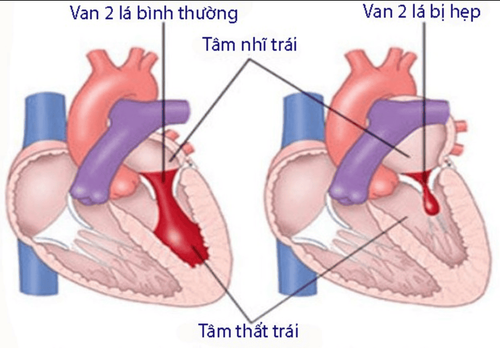This is an automatically translated article.
The article is professionally consulted by Master, Doctor Do Xuan Chien and Master, Doctor Hoang Thi Hoa - Department of Medical Examination and Internal Medicine - Vinmec Ha Long International General Hospital.Pulmonary stenosis is a condition in which the flow of blood from the heart to the lungs is obstructed, caused by a deformed and narrowing of the pulmonary valve, or a deformity above or below the valve. In adults there are sometimes problems as a complication of another disease, but most pulmonary stenosis develops before birth.
1. What is pulmonary valve stenosis?
Pulmonary stenosis is a congenital heart defect, usually diagnosed within the first few hours after birth. In pulmonary stenosis, the valve that allows blood out of the heart to reach the child's lungs (pulmonary valve) is abnormal.Instead of opening and closing to allow blood to travel from the heart to the lungs, the valve is formed as a solid tissue. So the blood cannot move normally to get oxygen from the lungs. Instead, some of the blood travels to the lungs via other natural pathways in the heart and its arteries.
These passages are needed when the baby is developing in the womb and they usually close soon after the baby is born. Children with pulmonary stenosis often have bluish skin because the body is not getting enough oxygen
Pulmonary stenosis is a life-threatening situation. Procedures to correct heart disease and medications to help a child's heart work more efficiently are the first steps in treating pulmonary stenosis.
2. Symptoms of pulmonary valve stenosis
Symptoms of pulmonary valve stenosis may include:Heart murmur. Shortness of breath, especially during exertion. Chest pain. Loss of consciousness (fainting). Tired. If you have pulmonary stenosis or other heart problems, prompt evaluation and treatment can help reduce your risk of complications.

3. Is pulmonary stenosis dangerous?
People with mild to moderate pulmonary stenosis are less likely to have complications, but with higher levels of regurgitation, the patient is at increased risk for the following complications:Infection: People with problems structural heart disease such as pulmonary stenosis, there is an increased risk of developing a bacterial infection in the inner lining of the heart (infective endocarditis). Heart pumping problems: In severe pulmonary stenosis, the right ventricle must pump harder to get blood into the pulmonary artery. The right ventricle resists the increased pressure causing the muscle of the ventricular wall to thicken and the chamber inside the ventricle to enlarge (this is called right ventricular hypertrophy). Eventually, the heart becomes stiff and may weaken. Heart failure: If the right ventricle becomes weak and cannot pump blood effectively, heart failure develops. This leads to swelling in the legs and abdomen, which can also cause fatigue and shortness of breath. Irregular heartbeat (arrhythmia): People with pulmonary stenosis are more likely to have an irregular heartbeat. Unless the stenosis is severe, the irregular heartbeat associated with pulmonary stenosis is usually not life-threatening.
4. Treatment of pulmonary valve stenosis

4.1. Medication For moderate to severe cases, your doctor may prescribe some medications to relieve symptoms such as:
Drugs that increase blood flow through the heart (prostaglandin). Medicines that make the heart beat faster. Medicines that prevent blood clotting. Medicines remove excess fluid. Medicines for irregular heart rhythms. In particular, some patients are prescribed even prophylactic antibiotics to avoid endocarditis infection in subjects with weak resistance such as the elderly, children, people with chronic diseases...
4.2. Pulmonary valve repair with a balloon This is done if you don't have other heart defects. Using cardiac catheterization to treat pulmonary stenosis.
In this procedure, a small tube is passed through a vein in the leg to the heart. The deflated balloon is placed where the pulmonary valve narrows. The doctor then opens the balloon, opening the narrow pulmonary valve and increasing the area available for blood flow. This ball is then removed.
The most common side effect of balloon valve repair is regurgitation, in which some blood backs up through the pulmonary valve after the balloon is opened. But the benefits associated with this approach often outweigh the risk of valve regurgitation.
4.3. Open thoracic surgery to replace the pulmonary valve In some difficult cases, you will be applied this method to replace or repair the heart valve. During surgery, the doctor repairs the pulmonary valve to allow blood to pass more easily. In some cases, the doctor may replace the pulmonary valve with an artificial valve.
A replacement artificial valve will have a life span of several decades. However, thoracotomy always carries many great risks such as blood loss, infection, blood clots, and possibly death.

Eat lightly, eat less salt to avoid increasing the burden on the heart. Eat lots of green vegetables, fruits, heart-healthy foods like whole grains, lean meat, chicken, fish; Limit eating red meat, fried foods high in fat. Do not use stimulants such as coffee, tobacco, alcohol. Exercise with moderate sports such as walking, meditation, yoga, cycling. Avoid anxiety, stress, get enough sleep 6-8 hours a day. If you are pregnant and have severe valve regurgitation, you need to see your doctor regularly, because you may be prescribed angioplasty to avoid complications during delivery. In general, pulmonary stenosis should not be a serious problem if your condition is mild, leads a healthy lifestyle, and provides effective heart care. If you have obvious symptoms of this disease or have been treated but have signs of recurrence, you should immediately see a cardiologist for timely examination and treatment to avoid dangerous complications.
Please dial HOTLINE for more information or register for an appointment HERE. Download MyVinmec app to make appointments faster and to manage your bookings easily.














